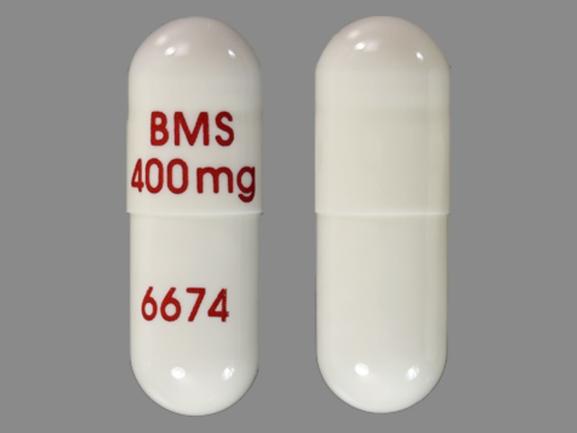Videx EC Disease Interactions
There are 8 disease interactions with Videx EC (didanosine).
- Renal dysfunction
- Bone marrow suppression
- Hepatotoxicity
- Pancreatitis
- Peripheral neuropathy
- Hyperuricemia
- PKU
- Sodium
DdI (applies to Videx EC) renal dysfunction
Major Potential Hazard, High plausibility.
Didanosine (ddI) is primarily eliminated by the kidney. Patients with renal impairment may be at greater risk for ddI-related toxicity due to decreased drug clearance. Therapy with ddI should be administered cautiously at reduced dosages in patients with renal impairment.
NRTIs (applies to Videx EC) bone marrow suppression
Major Potential Hazard, Moderate plausibility. Applicable conditions: Bone Marrow Depression/Low Blood Counts
The nucleoside reverse transcriptase inhibitors, didanosine (ddI), zalcitabine (ddC) and stavudine (d4T), may infrequently cause bone marrow suppression at recommended dosages. Anemia, leukopenia, thrombocytopenia and neutropenia have been reported. Therapy with these agents should be administered cautiously in patients with preexisting bone marrow depression or blood dyscrasias. Routine blood counts are recommended.
NRTIs (applies to Videx EC) hepatotoxicity
Major Potential Hazard, Moderate plausibility. Applicable conditions: Alcoholism, Liver Disease
Hepatotoxicity including lactic acidosis, severe hepatomegaly with steatosis, fulminant hepatitis, and hepatic failure has been associated with the use of some nucleoside reverse transcriptase inhibitors (NRTIs) alone or in combination with other antiretroviral agents. Therapy with NRTIs should be administered cautiously in patients with preexisting liver disease, a history of alcohol abuse, or hepatitis. Therapy should be suspended if clinical or laboratory findings suggestive of lactic acidosis or pronounced hepatotoxicity occur. The use of abacavir is contraindicated in patients with moderate to severe liver dysfunction as its safety and efficacy have not been established in these patients.
NRTIs (applies to Videx EC) pancreatitis
Major Potential Hazard, Moderate plausibility. Applicable conditions: Hyperlipidemia, Alcoholism
The nucleoside reverse transcriptase inhibitors, didanosine, stavudine, and lamivudine, may cause pancreatitis. The incidence is generally low but is up to 7% with didanosine, and up to 18% in pediatric patients given lamivudine. Patients with a history of or known risk factors for pancreatitis (such as alcohol abuse or hypertriglyceridemia) should be monitored closely during therapy with these agents. Therapy should be discontinued at the first signs/symptoms suggestive of pancreatitis (e.g., nausea, vomiting, abdominal pain, hyperamylasemia with dysglycemia, rising triglycerides, decreasing serum calcium), and preferably permanently discontinued if clinical pancreatitis develops.
NRTIs (applies to Videx EC) peripheral neuropathy
Major Potential Hazard, High plausibility.
The nucleoside reverse transcriptase inhibitors, didanosine (ddI), zalcitabine (ddC), and stavudine (d4T), may commonly cause dose-related peripheral neuropathy, particularly in patients with advanced HIV disease. Usually, the neuropathy resolves slowly following prompt discontinuation of therapy, but it can be irreversible. These agents should be administered cautiously to patients with a history of neuropathy and avoided in patients with existing polyneuropathy. Therapy may be reinstituted following resolution of symptoms in patients who have previously experienced neuropathy with these drugs, but reduced dosages are recommended.
DdI (applies to Videx EC) hyperuricemia
Moderate Potential Hazard, Moderate plausibility. Applicable conditions: Gout
Didanosine (ddI) may infrequently cause hyperuricemia. Patients with preexisting hyperuricemia or gout should be monitored for exacerbation of condition during ddI therapy.
DdI (applies to Videx EC) PKU
Moderate Potential Hazard, High plausibility. Applicable conditions: Phenylketonuria
Videx (brand of didanosine, or ddI) chewable/dispersable buffered tablets contain 36.5 mg of phenylalanine per each 25, 50, 100, and 150 mg tablet. The phenylalanine content should be considered when these products are used in patients who must restrict their intake of phenylalanine (i.e. phenylketonurics).
DdI (applies to Videx EC) sodium
Moderate Potential Hazard, High plausibility. Applicable conditions: Renal Dysfunction, Congestive Heart Failure, Hypernatremia, Hypertension, Fluid Retention
Didanosine (ddI) formulations have a high sodium content. There are 265 mg of sodium per tablet and 1380 mg per packet of powder for oral solution, which may be of concern in patients with conditions that may be adversely affected by excessive amounts of sodium, such as congestive heart failure, hypertension, and fluid retention. Each tablet also contains 8.6 mEq of magnesium. Patients with significant renal impairment may not tolerate these loads.
Switch to professional interaction data
Videx EC drug interactions
There are 249 drug interactions with Videx EC (didanosine).
Videx EC alcohol/food interactions
There are 3 alcohol/food interactions with Videx EC (didanosine).
More about Videx EC (didanosine)
- Videx EC consumer information
- Check interactions
- Compare alternatives
- Drug images
- Side effects
- Dosage information
- During pregnancy
- Drug class: nucleoside reverse transcriptase inhibitors (NRTIs)
- Breastfeeding
Related treatment guides
Drug Interaction Classification
| Highly clinically significant. Avoid combinations; the risk of the interaction outweighs the benefit. | |
| Moderately clinically significant. Usually avoid combinations; use it only under special circumstances. | |
| Minimally clinically significant. Minimize risk; assess risk and consider an alternative drug, take steps to circumvent the interaction risk and/or institute a monitoring plan. | |
| No interaction information available. |
See also:
Further information
Always consult your healthcare provider to ensure the information displayed on this page applies to your personal circumstances.


